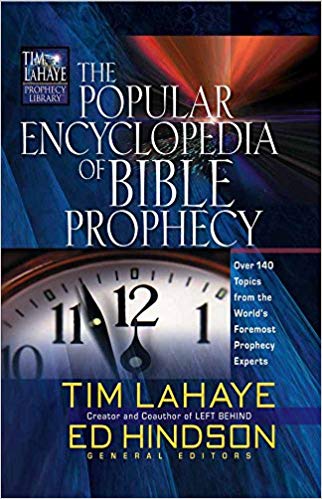ABOMINATION OF DESOLATION PART 2

THE POPULAR ENCYCLOPEDIA OF BIBLE PROPHECY
The Abomination Of Desolation Part 2
HISTORICAL BACKGROUND
During the construction of the Second Temple, a host of actual and would-be desecrators of the Temple invaded Jerusalem. However, Daniel appears to be predicting the invasion of the Syrian–Greek ruler Antiochus
IV Epiphanes (175–164 b.c.), who erected an idol in the Temple near the Brazen Altar. In Daniel 11:31 we read, “Forces from him will
arise, desecrate the sanctuary fortress [Temple compound], and do away with the regular sacrifice. And they will set up the abomination of desolation.” This occurred in 167 b.c. In response, the Jewish priests revolted and rededicated the Temple (an event commemorated
as the Feast of the Dedication in John 10:22-23), leading to a Jewish military overthrow of Antiochus’ forces. Some critical scholars have dismissed an
eschatological interpretation of the abomination of desolation in Daniel, assuming all references must refer to Antiochus’ desecration
and claiming Daniel was written after this event. However, Jesus understood that the historical application of the phrase to Antiochus’
desecration was a pattern of the ultimate eschatological event—the abomination of the Antichrist. Citing Daniel’s prophecy (some 200 years after Antiochus’ desecration) and referring to the still-future abomination
of desolation (Matthew 24:15; Mark 13:14),Jesus affirmed both His and Daniel’s awareness of the eschatological application of the phrase.
PROPHETIC IMPLICATIONS
Jesus saw His message as a continuation of the biblical prophets and evaluated His generation in the light of them. He frequently cited Jeremiah and Zechariah and applied these prophecies to the soon-coming judgment
of Jerusalem in a.d. 70 as well as the more distant final judgment. For example, at the “cleansing of the Temple,” Jesus quoted
both Jeremiah 7 (which referred the threat of ritual defilement to the Temple following Jeremiah’s Temple sermon) and texts in Isaiah
and Zechariah (which referred to the Temple’s future state). Jesus’ Olivet Discourse also sets the Temple in an eschatological context. When the disciples heard Jesus’ prediction of the Second Temple’s destruction (Matthew 24:1-2; Mark 13:1-2; Luke 21:5-6), they apparently
connected it to the messianic advent at the end of the age and asked for a sign (Matthew 24:3;Mark 13:4; Luke 21:7; see also 1 Corinthians 1:22). The “sign”He gave them was that of Daniel’s abomination of desolation
(Matthew 24:15;Mark 13:14). This, then, was the sign that the Jewish nation was nearing the time of messianic deliverance and restoration,for the desecration of the Temple would begin the persecution of the Jewish people
(that is, the “great Tribulation,” Matthew 24:16-22; Mark 13:14b-20). Only the Messiah Himself will be able to bring them redemption from their enemies (Matthew 24:30-31;Mark 13:26-27; Luke 21:28). Luke’s account does not include the abomination of desolation in the Temple because this
is an eschatological event, and he has selectively focused on the immediate concern of the disciples (note the phrase “about to take place”
in Luke 21:7) concerning when the predicted destruction of the Temple (and Jerusalem) would occur. For this reason he also omits the end-time persecution of the Tribulation (Greek, thlipsis), which is connected with this
event, substituting the term “great distress”(Greek, anagke), which better describes the local invasion and trampling of the city (Luke
21:23-24), fulfilled in the Roman conquest of Jerusalem in a.d. 70. Matthew and Mark place the abomination of desolation in the time when “the end will come” (Matthew 24:14). It separates the period of “tribulations” or “birth pangs” (Matthew 24:6-12; Mark 13:7-9) from the “great tribulation”
period (Matthew 24:21; Mark 13:19). Luke does this in Luke 21:24 by separating the event of Jerusalem’s desolation (a.d. 70) and the times of the Gentiles (present age) from the time when “the times of the Gentiles are
fulfilled.”The abomination of desolation marks the midpoint of Daniel’s seventieth week, dividing the Tribulation into two divisions of lesser
and greater intensity (Daniel 9:27). This corresponds
to the “42 months” of Revelation 11:1-2 and the 1290 days of Daniel 12:11.
Preterists interpret the abomination of desolation (as they do most prophetic events) as having its ultimate fulfillment in the destruction
of the Temple in a.d. 70. However, the events of the First Revolt that culminated with the destruction of a.d. 70 do not match the details in the “abomination of desolation” texts. None of the incursions by Roman officials during this time could be regarded as abominations that caused desolation because they did not affect the sacrificial system. Foreigners
in the Temple may desecrate the Temple without defiling it. That is why the
Jews could rebuild the Temple after its desecration and destruction by the Babylonians without the need of a purification ceremony (Ezra 3:2-13). Further, the entrance of the Roman general Titus (who destroyed the
Temple) occurred only after the Sanctuary was already in flames and had been largely ruined and after the Jewish sacrifices had ceased. This is important to note since the abomination of desolation of which Daniel
speaks, and to which Jesus refers, speaks only of the cessation of sacrifice in the Temple, not of the Temple’s destruction.
ESCHATOLOGICAL FOCUS
Any interpretation except the eschatological leaves us with unresolved details that we must either interpret in a nonliteral, nonhistorical
manner, or dismiss altogether. The eschatological view also explains the meaning of types that await their anti-type for ultimate fulfillment. Moreover, Daniel’s seventieth week, and especially its signal event of the abomination of desolation, influenced the literary structure of the Olivet Discourse and the judgment section of the book of Revelation (chapters 6–19). Jesus’ interpretation of the order of the events of the seventieth week in the context of prophetic history appears to confirm an eschatological interpretation for Daniel 9:27. Matthew 24:7-14 predicts that persecution, suffering, and wars will continue to the end of the age, climaxing in a time of unparalleled distress (verses 21-22). This corresponds to “the time of Jacob’s distress” (Daniel 12:1; Jeremiah 30:7). Only after these events does Jesus make reference to Daniel 9:27 (verse 15) concerning the signal event of this time of Tribulation. If the seventy sevens (kjv, “weeks”) were to run sequentially, without interruption, then why does Jesus place this intervening period before the fulfillment of the events of the seventieth week? The text of Matthew in particular shows that Jesus was answering His disciples’ questions concerning His second coming and the end of the age (Matthew 24:3). Jesus here explains that His coming is necessary for divine intervention and national repentance (verses 27-31; Zechariah 12:9-10) and will occur “after the tribulation of those days” (Matthew 24:29). According to Matthew, the events described in this period prior to the messianic advent could not have been fulfilled in a.d. 70 with the destruction of Jerusalem because these events usher in and terminate with the coming of Messiah. Although the phrase abomination of desolation does not appear in Paul’s description of the end-time desecration of the Temple in 2 Thessalonians 2:4, he obviously has this event in view. For example, the Septuagint sometimes uses both bdelugma (“abomination”) and anomia (“lawlessness”) to refer to idolatrous practices. Thus in 2 Thessalonians 2:3-4, Paul describes the figure who magnifies himself above every idol as “the man of lawlessness.” In fact, Paul’s explanation of this event serves as a commentary on both Daniel’s “abomination of desolation” texts (particularly Daniel 9:27) and Jesus’ statement of it as a “sign” in the Olivet Discourse.Moreover, Paul uses the event to answer the same time-related question of the end time that Jesus’ disciples asked. This further affirms the eschatological interpretation of the abomination of desolation. Paul wrote to the Thessalonian church to admonish Christians who had abandoned the
normal affairs of life. They believed the imminent coming of Christ that Paul had previously espoused (1 Thessalonians 4:13-18) was already
set in motion (2 Thessalonians 2:2). Paul explained that before the “appearance” of the Messiah, the Antichrist must first appear (verses
3-9). The signal event that will manifest the Antichrist, whom this text refers to as “the man of lawlessness,” “the son of destruction” (verse 3b), and “that lawless one” (verse 8), is his usurpation of God’s place in the Temple (verse 4; see also Exodus 25:8). This act will reveal not only the Antichrist but also “the lie”(the deification of the Antichrist, Revelation 13:4-6,15) that will mark his followers (Revelation 13:16-18) and confirm them in the eschatological judgment that will occur at the coming of the Lord (2 Thessalonians 2:8-12).

